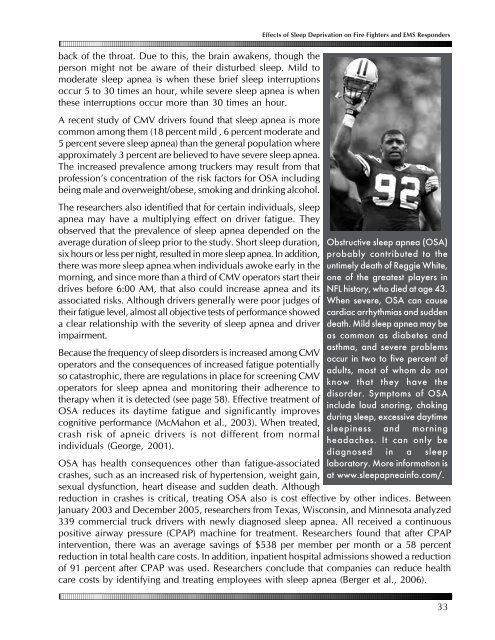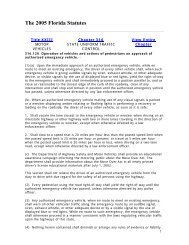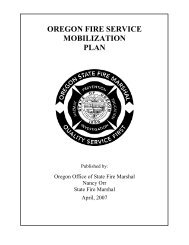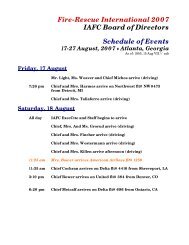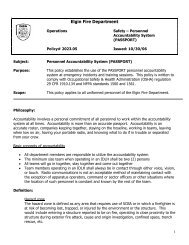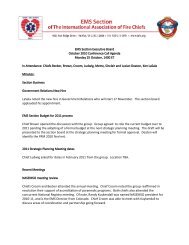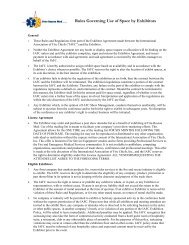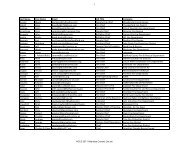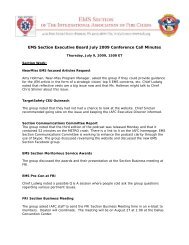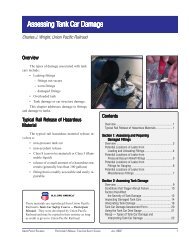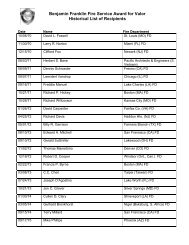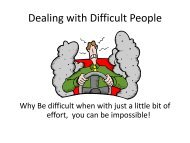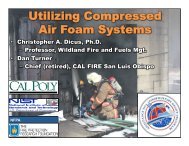Effects of Sleep Deprivation on Fire Fighters and EMS ... - NAEMT
Effects of Sleep Deprivation on Fire Fighters and EMS ... - NAEMT
Effects of Sleep Deprivation on Fire Fighters and EMS ... - NAEMT
Create successful ePaper yourself
Turn your PDF publications into a flip-book with our unique Google optimized e-Paper software.
<str<strong>on</strong>g>Effects</str<strong>on</strong>g> <str<strong>on</strong>g>of</str<strong>on</strong>g> <str<strong>on</strong>g>Sleep</str<strong>on</strong>g> <str<strong>on</strong>g>Deprivati<strong>on</strong></str<strong>on</strong>g> <strong>on</strong> <strong>Fire</strong> <strong>Fighters</strong> <strong>and</strong> <strong>EMS</strong> Resp<strong>on</strong>ders<br />
back <str<strong>on</strong>g>of</str<strong>on</strong>g> the throat. Due to this, the brain awakens, though the<br />
pers<strong>on</strong> might not be aware <str<strong>on</strong>g>of</str<strong>on</strong>g> their disturbed sleep. Mild to<br />
moderate sleep apnea is when these brief sleep interrupti<strong>on</strong>s<br />
occur 5 to 30 times an hour, while severe sleep apnea is when<br />
these interrupti<strong>on</strong>s occur more than 30 times an hour.<br />
A recent study <str<strong>on</strong>g>of</str<strong>on</strong>g> CMV drivers found that sleep apnea is more<br />
comm<strong>on</strong> am<strong>on</strong>g them (18 percent mild , 6 percent moderate <strong>and</strong><br />
5 percent severe sleep apnea) than the general populati<strong>on</strong> where<br />
approximately 3 percent are believed to have severe sleep apnea.<br />
The increased prevalence am<strong>on</strong>g truckers may result from that<br />
pr<str<strong>on</strong>g>of</str<strong>on</strong>g>essi<strong>on</strong>’s c<strong>on</strong>centrati<strong>on</strong> <str<strong>on</strong>g>of</str<strong>on</strong>g> the risk factors for OSA including<br />
being male <strong>and</strong> overweight/obese, smoking <strong>and</strong> drinking alcohol.<br />
The researchers also identified that for certain individuals, sleep<br />
apnea may have a multiplying effect <strong>on</strong> driver fatigue. They<br />
observed that the prevalence <str<strong>on</strong>g>of</str<strong>on</strong>g> sleep apnea depended <strong>on</strong> the<br />
average durati<strong>on</strong> <str<strong>on</strong>g>of</str<strong>on</strong>g> sleep prior to the study. Short sleep durati<strong>on</strong>,<br />
six hours or less per night, resulted in more sleep apnea. In additi<strong>on</strong>,<br />
there was more sleep apnea when individuals awoke early in the<br />
morning, <strong>and</strong> since more than a third <str<strong>on</strong>g>of</str<strong>on</strong>g> CMV operators start their<br />
drives before 6:00 AM, that also could increase apnea <strong>and</strong> its<br />
associated risks. Although drivers generally were poor judges <str<strong>on</strong>g>of</str<strong>on</strong>g><br />
their fatigue level, almost all objective tests <str<strong>on</strong>g>of</str<strong>on</strong>g> performance showed<br />
a clear relati<strong>on</strong>ship with the severity <str<strong>on</strong>g>of</str<strong>on</strong>g> sleep apnea <strong>and</strong> driver<br />
impairment.<br />
Because the frequency <str<strong>on</strong>g>of</str<strong>on</strong>g> sleep disorders is increased am<strong>on</strong>g CMV<br />
operators <strong>and</strong> the c<strong>on</strong>sequences <str<strong>on</strong>g>of</str<strong>on</strong>g> increased fatigue potentially<br />
so catastrophic, there are regulati<strong>on</strong>s in place for screening CMV<br />
operators for sleep apnea <strong>and</strong> m<strong>on</strong>itoring their adherence to<br />
therapy when it is detected (see page 58). Effective treatment <str<strong>on</strong>g>of</str<strong>on</strong>g><br />
OSA reduces its daytime fatigue <strong>and</strong> significantly improves<br />
cognitive performance (McMah<strong>on</strong> et al., 2003). When treated,<br />
crash risk <str<strong>on</strong>g>of</str<strong>on</strong>g> apneic drivers is not different from normal<br />
individuals (George, 2001).<br />
OSA has health c<strong>on</strong>sequences other than fatigue-associated<br />
crashes, such as an increased risk <str<strong>on</strong>g>of</str<strong>on</strong>g> hypertensi<strong>on</strong>, weight gain,<br />
sexual dysfuncti<strong>on</strong>, heart disease <strong>and</strong> sudden death. Although<br />
Obstructive sleep apnea (OSA)<br />
probably c<strong>on</strong>tributed to the<br />
untimely death <str<strong>on</strong>g>of</str<strong>on</strong>g> Reggie White,<br />
<strong>on</strong>e <str<strong>on</strong>g>of</str<strong>on</strong>g> the greatest players in<br />
NFL history, who died at age 43.<br />
When severe, OSA can cause<br />
cardiac arrhythmias <strong>and</strong> sudden<br />
death. Mild sleep apnea may be<br />
as comm<strong>on</strong> as diabetes <strong>and</strong><br />
asthma, <strong>and</strong> severe problems<br />
occur in two to five percent <str<strong>on</strong>g>of</str<strong>on</strong>g><br />
adults, most <str<strong>on</strong>g>of</str<strong>on</strong>g> whom do not<br />
know that they have the<br />
disorder. Symptoms <str<strong>on</strong>g>of</str<strong>on</strong>g> OSA<br />
include loud snoring, choking<br />
during sleep, excessive daytime<br />
sleepiness <strong>and</strong> morning<br />
headaches. It can <strong>on</strong>ly be<br />
diagnosed in a sleep<br />
laboratory. More informati<strong>on</strong> is<br />
at www.sleepapneainfo.com/.<br />
reducti<strong>on</strong> in crashes is critical, treating OSA also is cost effective by other indices. Between<br />
January 2003 <strong>and</strong> December 2005, researchers from Texas, Wisc<strong>on</strong>sin, <strong>and</strong> Minnesota analyzed<br />
339 commercial truck drivers with newly diagnosed sleep apnea. All received a c<strong>on</strong>tinuous<br />
positive airway pressure (CPAP) machine for treatment. Researchers found that after CPAP<br />
interventi<strong>on</strong>, there was an average savings <str<strong>on</strong>g>of</str<strong>on</strong>g> $538 per member per m<strong>on</strong>th or a 58 percent<br />
reducti<strong>on</strong> in total health care costs. In additi<strong>on</strong>, inpatient hospital admissi<strong>on</strong>s showed a reducti<strong>on</strong><br />
<str<strong>on</strong>g>of</str<strong>on</strong>g> 91 percent after CPAP was used. Researchers c<strong>on</strong>clude that companies can reduce health<br />
care costs by identifying <strong>and</strong> treating employees with sleep apnea (Berger et al., 2006).<br />
33


